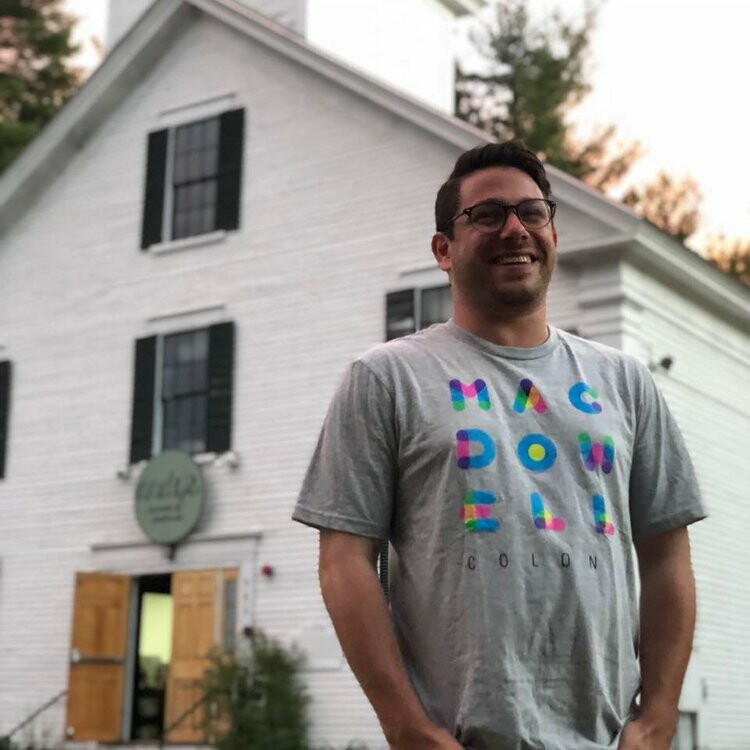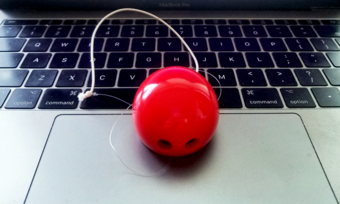Try this on for size: What if the future of theatre is hidden right in front of us, coaxing us into utter recklessness of experimentation? What if theatre’s identity is not lost in the digital, but instead is enhanced in it? What if the word “digital” is no longer equated to just film or television, but is used to invigorate a new aspect of our form? What if this moment isn’t just seen as a replacement until theatres open again? Because theatre, as an idea, can thrive right now even when theatre, as a location, is temporarily closed.
The future of theatre can and will achieve all that I mentioned above. It can simultaneously move further into a digital liveness while also re-engaging with the sacred experience of in-person performance. It will invite a new, youthful audience and artistic community into the form by answering to decades-old accessibility issues. It can emerge as the relevant mirror to our digitally saturated world and investigate online/offline relationships, conflicts, and communities like theatre has done for centuries alongside its culture. All of this, however, requires that theatre—right now—actually practice the form of theatre, or else all of these opportunities will be lost.
In other words, theatre must stop making films during the pandemic.
There! I said it. And I believe doing so will be the most exciting way to unlock the future.
Theatre’s decision to make films, which is currently happening nationwide, is exposing a fear of technology alongside a mistrust of liveness, and it is leading to a dependency on specific usages of technology that are irrelevant to our form once we return to being in-person. This is such a waste of an opportunity! And it is imperative that the community understand why and how to overcome their fears.
Adding an editor to the theatrical process, post-performance, is a curation of the living, breathing moment. It opens up a certain type of liberty in storytelling that is antithetical to theatre’s embrace of time, space, response, and, unapologetically, mortality. Worst of all, it strips the theatre of its strongest currency: imagination in the present moment. The industry is saturated with imagination, where artists creatively overcome challenges of immediate storytelling. We don’t need an editor post-production, ever. In this new digital environment, resisting the post-production process might lead to incredibly inspiring strategies that no filmmaker would ever have imagined. Let’s use that innate tool to crack open a digitally flexible, sacredly human future.
Now, look, I understand why the alternative to filmmaking during this time period might feel terrifying. Creating live digital performance may look like a loss of product control. If it’s live, we must commit to a very temporal event that’s occurring in real time. But isn’t that what theatre always is? Perhaps the real fear of product is driven by the assumption that it must either replicate film or have it be a documentation of performance on a stage. In both scenarios, the audience must compare this product to the product it is replicating. That will inevitably lead to disappointment.
This present moment places us in an exciting crossroad between former traditions and the emergence of technical and multi-platformed storytelling.
Instead of allowing this fear to drive us away from what we do best (live events), we should use it to recommit ourselves to the essence of what makes theatre truly remarkable. This essence has nothing to do with location or video quality. Theatre’s essence is found in the presentation of a seemingly impossible task laid out before an audience in real time, demanding everyone use their imagination to help generate this fantastical event. This will require experimentation and playfulness though, which will demand theatremakers to overcome the paralyzing fear of product control. If we can do that today, under our current circumstances—which I believe we can—we will be prepared for the impending revolution tomorrow.
To accept the challenge of experimentation, however, is a resolve to get messy and relish in failure so that new strategies can emerge for a future theatre. To me, failure is thrilling. Through failure, there’s still success—it not only helps the artist define what does and doesn’t work, it also leads to an impulsively unexpected result when the artist tries to “just make it work in the moment.” If a film shoot was failing, there would always be an opportunity to fix it in post-production. However, if a theatrical team is attempting to create a consistently evocative moment that must be reproduced in real time over multiple performances, the strategies to survive and overcome failure become quite different.
This problem-solving is what will allow our form to thrive again, even in the virtual space. It will show us how theatre can maintain its identity, because no filmmaker would ever solve the problem in the way a theatre practitioner would. Embracing liveness will inevitably lead to a unique result.
As theatre chooses to make films during the pandemic, we may incorrectly start viewing innovation as failure.
If an audience sees edited cuts and obvious non-live events telling a story in what they thought was a theatrical event, they will begin to view the product with a value system akin to film. This is exceptionally dangerous to theatre, as it strips away the opportunity for the work to be viewed in a theatrical way successfully. In film, if Superwoman needs to fly, a filmmaker uses computer-generated imagery and special effects that involve a large team of content generators. In theatre, though, a practitioner gets a sheet and two chairs and asks an ensemble to lift her up. When placing those solutions side by side, one appears more of a failure. But in actuality the solution for theatre is brilliant because it overcomes the given constraints in imaginative ways. The audience is aware of this and joyously buys into the conceit, adding to the theatrical success.
So, how might a team of theatre artists create the same synergy in a virtual space? Do it live. Use this restriction as a prompt to explore all of the capabilities of technology like you would a set onstage. Abandon the need to behave like film and investigate how to use these tools to enhance theatre. Let this lead to playfulness instead of disappointment. We are not filmmakers, we are theatre artists. And in embracing that, the future of theatre will deliver to its audiences a needed understanding of how to be more present in a world overtaken by technology, because we—as theatre artists—will know how to create imaginative worlds that can blend technology and reality organically. That’s a future of theatre I can get behind.
As theatre chooses to make films during the pandemic, we may incorrectly start viewing innovation as failure.
Imagine a future where theatre can show the world how the internet is a living, breathing, site-specific treasure trove of real-time performance.
The need for experimentation is upon us, and to do so we must relinquish the former environments of theatremaking and embrace the current performance venue: the world wide web. To be crystal clear, this does not mean to forever replace the former in-person performance venue. When the creators of Sleep No More opened their show, no one voiced the concern that performing in a warehouse might have the danger of replacing traditional theatres venues. The theatre is a location in which theatre can exist, but theatre has survived many permutations. It has traversed fields and taxi cabs and parades, has taken place in tents and on wagons…. So why not on the internet? In fact, saying “the internet” isn’t even naming one specific format, it’s naming categories upon categories of forms, from video gaming to virtual reality to TikTok to Twitter to Zoom to avatars. The possibilities are endless. This should excite us!
Why are we so afraid to test out the strength of live theatre over the world wide web? Are we afraid to fail? Because choosing to avoid the innate form of live theatre will, alternatively, stall us from innovating new forms of collaborations in the future. As was the case with Sleep No More, many artists who attended those performances found themselves inspired by the experimentation of form and infused those musings into future works. On the virtual stage, we must also embrace the same potential. The act of experimentation should be viewed as a valued product just as much as the event itself.
But why experiment now, when we are in a virtual space and not in a theatre? To me, this question is vital. If theatre aims to hold a mirror up to society, we as theatre artists must embrace the fact that digital life is as important as real life. This is not a request for more spectacle, but instead an opportunity to deepen our psychological and emotional engagement with technology in the world. Theatre must wield technology as much as its audiences do in order to even begin to impact the future of our culture. This is the opportunity to become leaders between technology and the humanities! Consider it a crash course in the subject so we can pierce through the veil of virtual screens and maintain an immediacy for our audiences. What a gift to give our patrons.
Embracing the challenges of the virtual world grants us an opportunity to examine process from an entirely new perspective.
This is an amazing moment to interrogate the processes instilled in us as theatremakers of the late twentieth and early twenty-first centuries. Our analog environment is currently inverted into a digital platform, our collaborations are off-balance, and our products are unknown. By embracing theatremaking in these new, virtual environments, we can dismantle the inherent hierarchy of process and create a more cyclic and inclusive collaboration.
The virtual rehearsal space obliterates the so-called conveyor-belt process of old—where the playwright passes the script to the director who meets with a scenic designer and then distills the environment to the remaining creative team. Simultaneously, this virtual environment disintegrates the rehearsal process where actors rehearse in isolation from designers until a rapid implementation of tech in three to five days at the very end. Online, nothing can be viewed accurately without the creative team present alongside the performers so that everyone can see the exact composition in which the performance takes place. The sequence of events becomes a circle in which all parts are equal, mostly because no one knows what the product is until it is in front of them.
Most of my own pandemic rehearsal processes have been an intense layout of technology with the actors first. Those first rehearsals are the equivalent of “taping out the space”—something that the stage managers usually do for the actors to understand the world they will eventually inhabit. Once we’ve walked through all of the show’s tech, we approach the script and embark on table work together as a full team. Table work, therefore, holds an understanding of the total work of art because everyone has experimented and experienced the process together.
If theatre aims to hold a mirror up to society, we as theatre artists must embrace the fact that digital life is as important as real life.
When I began rehearsals for Russian Troll Farm, written by Sarah Gancher, no one in the rehearsal room knew what to expect. Because of this, it was vital we surrounded ourselves with artists who were willing to take risks, trust experimentation, and be unabashedly excited by doing it live. This was an energy I had been yearning to experience in a rehearsal room for years. Everyone, from designer to actor, was a primary author and a barometer to the experience, naming what was and wasn’t resonating for them. My co-director, Elizabeth Williamson, and I found that everyone served as theatre-scientists looking at our form through a new lens. Even in the most exhausting days, we knew our findings might influence a future for theatre. Stumbling in the dark never felt so exciting. And while there were days that nearly broke us, I found three simple truths to be exceptionally helpful:
- Technology is an extension of the performers and must be seen as a tool they need to know how to use alongside the story they shape. However long it takes to build that confidence is how long it takes, no questions asked.
- Even with time restraints, never surrender from the commitment to performing live. Filming is not an option, because as theatre-scientists filming is not the process to deepen our passion for theatre. Laughter becomes the ammunition against impossibility and will always lead us to reckless experimentation where nothing is off-limits. Releasing ourselves from such anxiety will always lead to unexpected solutions.
- Everyone’s point of view matters because no one has ever experienced this process or the struggle before. Voicing points of view from everyone’s perspective is a way to acquire all findings of the experiment and allows for collective discourse that holds no hierarchy.
So many times we wanted to give up on these truths, to make it easier on all of us. But we ended every session with a statement of conviction that we were experimenters and therefore we were exactly where we needed to be. Experimentation, by nature, is a discovery and identification of process. The pandemic halted a form of theatre that was too complacent in its conveyor belt of creation under specific processes, steeped in the methodical sequencing of rehearsal, tech, previews, and opening. When virtual spaces became the modus operandi, experimentation became inevitable to distill what theatre is at its essence and what is essential in order to prevail.
It is the openness to experimentation of process and room dynamics that can point to a future more equitable in resources and power. A group collectively unearthing a product that no one has any preconceived idea of can teach us how to hold healthy practices of generative theatremaking. Even though we are not in the physical space together, the collaborative strategies within the virtual space can have deep impact on group dynamic, collective imagination, and cyclical art-making. Embracing this in today’s virtual realm can serve as calisthenics towards an inspired return to our in-person environment.
And the future of theatre is the resiliency found when overcoming a pandemic by remaining as itself throughout the pandemic.
Don’t abandon the essence of theatre right now, for the future of our form is upon us.
Pre-pandemic, when we theatremakers faced challenges in an actual venue, we would collaborate with the team towards a theatrical solution. When our anxieties increased in tech, as we neared opening night, we’d converse with the creative team to distill what is clear and what needs simplifying. We must ask ourselves why, here in this virtual space, we are so quick to jump from the conceit of theatremaking in the face of struggle. If it is a fear of product, then let’s redefine product! If it is a lack of technical comprehension, let’s simplify. If it is a disappointment in the video quality, we must ask why we are trying to equate ourselves to the product of film. Whatever the case, creative struggle is not a foreign word in theatre. It has, and always will be, the beginning seeds of innovation.
Choosing to use this time to make a film instead of experimenting in theatre practices will amount to a Band-Aid that delays tending to our challenges until we return to the real space. We will lose the immediate opportunity to uncover unexpected practices of live, collaborative performance-building by being in this incredibly vast site-specific venue.
This time period allows us the chance to refresh our desire to create under extreme measures. It will undoubtably unlock totally new procedures to generate new work. It will encourage us to incorporate new, and younger, artistic voices into the creative process by investigating the digital world around us. It is our obligation to struggle in great ways in order to identify how this new environment might encourage alternative processes and, in turn, inspire cultural shifts in the world. By evolving our own processes and collaborations, embracing this moment with our innate theatrical tools could create an emergence of new content and form that the world so desperately needs right now.
And when this future theatre is thriving in the years to come, we will look back and realize it was because, in this challenging moment, we committed to our strength as theatre practitioners. Our strength isn’t just telling a story, our strength is being able to tell a story under any circumstance, in real time. It is there, and really only there, that theatre teaches us what it means to be human and to be mortal. It puts resiliency to the test and proves to all artmakers just how inspiring the form of theatre can be.
The future of theatre is always live.
The future of theatre is a continued effort to be multi-platformed.
The future of theatre embraces the digitally saturate world and continues to find what is most human in it.
The future of theatre is accessible.
The future of theatre is collaborative rehearsal spaces.
The future of theatre is full of experimentation.
The future of theatre is a commitment to risk.
And the future of theatre is the resiliency found when overcoming a pandemic by remaining as itself throughout the pandemic.
The future of theatre begins now.











Comments
The article is just the start of the conversation—we want to know what you think about this subject, too! HowlRound is a space for knowledge-sharing, and we welcome spirited, thoughtful, and on-topic dialogue. Find our full comments policy here